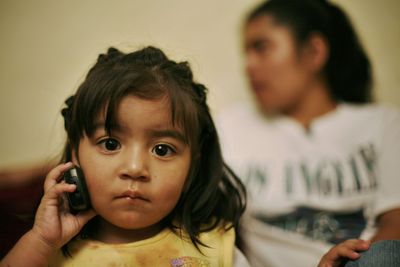Tenacity, DNA help reunite mother, girl
U.S. couple nearly adopt stolen Guatemalan baby

GUATEMALA CITY – For 14 months, Ana Escobar studied the tiny fingers of every passing baby, searching for a girl with pinkies that curved gracefully outward, just like those of her missing daughter.
Then one day she saw her, in the arms of a foster mother helping process her adoption by an Indiana couple: A straight-haired toddler who appeared to be a stranger, except for her unmistakable fingers.
“I was in shock. I could not move. I could not do anything,” Escobar said.
DNA tests eventually proved what Escobar already knew: The girl was her daughter, taken at gunpoint in March 2007, when she was just 6 months old.
Esther Sulamita is the first stolen Guatemalan baby found through a challenge of the mother-and-child DNA test results that are supposed to guarantee the legitimacy of each adoption.
She likely won’t be the last. Jorge Meng, spokesman for the attorney general’s office, said officials suspect more cases will be found because the lawyers in Esther’s case have vouched for documents in dozens of other pending adoptions, as well as many more involving children now growing up as Americans.
Authorities issued arrest warrants for a doctor, two lawyers and two others in Esther’s case. Authorities suspect they could find more than a dozen other stolen babies in their review of 2,286 pending U.S. adoptions.
Even some completed adoptions are being questioned. At least two are under investigation to determine if the children – now growing up as American citizens – were stolen, said Jaime Tecu, a former prosecutor who is leading the Guatemalan National Adoption Council’s review.
“After this, we are ordering DNA tests for all children whose mothers present credible indications that they were abducted, and we are asking parents of those two babies in the U.S. to voluntarily submit DNA tests of their adoptive children,” said Elizabeth Hernandez, council president.
Authorities have long believed that some of the nearly 5,000 Guatemalan babies adopted by U.S. couples each year were stolen and sold to baby brokers who worked with doctors and lawyers to create false identities for the children.
Guatemalan adoption officials say there is no evidence the Indiana couple knew the baby they were trying to adopt was stolen. Their attorney, Charlie Rice, said the two had already traveled to Guatemala and spent time caring for the girl.
“These people are absolutely devastated, absolutely horrified over the idea that a child was stolen from a mother,” Rice said. “There is grief over the loss of the child, but absolute joy that the mother has been found.”
Authorities have said adoptive U.S. families – many of whom spent $30,000 or more for what they were told are legitimately surrendered babies – are also victims of the corrupt old system, which is now being replaced.
At least two other stolen children have been found in nurseries that handled international adoptions – one with a fake identity – although neither had officially been put up for adoption yet, Tecu said.
Knowing she finally had her daughter back was the happiest moment of Escobar’s life, but there are cruel reminders of everything she lost. She still has almost no information about what happened to her child for more than a year.
Esther has no memory of her mother. She is withdrawn, aggressive and often refuses to eat.
“So far, she has not fully adapted to me. She … pulls my hair, bites and kicks me. You have no idea how hard it is when your own child rejects you,” Escobar said.
Esther does have moments, though, when events of the past year melt away. At a park, the toddler chased a cousin around a basketball court and squealed with delight. All the while, Escobar kept a close watch.